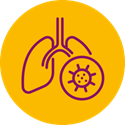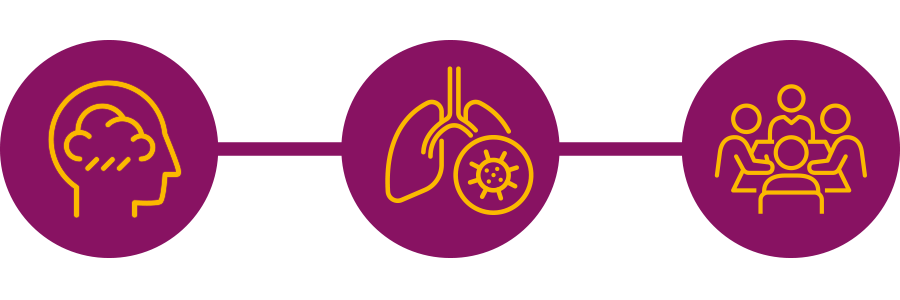NEWS
Tuesday 13 April 2021
Actors reuniting over video chat to recreate scenes, read scripts and reminisce – often raising money for great causes – has been a popular trend over the last year, with the casts of The Lord of the Rings, Back to the Future, The US Office and even Ghostbusters reuniting online in lockdown.1
Why are we talking about this in an article about long COVID, we hear you ask? Well, one TV reunion saw the cast of 1980s US soap opera Dynasty come together for a 40th anniversary special to raise money to help fund research into long COVID in the UK. Former Dynasty actress Emma Samms has suffered with the lingering effects of COVID for more than a year after first being diagnosed, so her co-stars reunited to bring attention to, and raise much needed money for, this serious condition.
In the early days of the pandemic the general view was that, for most people, COVID-19 was a relatively mild illness lasting no more than a couple of weeks, but which sadly hospitalised or killed a minority. After more than 120 million cases worldwide and more than 2.65 million deaths there’s now an acceptance that COVID is not a short illness for many people – even for some of those who only experienced mild symptoms of the virus.2
Long COVID – or long haul COVID as it’s known in the US, where patients are sometimes referred to as “long haulers”3 – is now a recognised condition and one which both employers and employees need to know about and to prepare for. The issue, however, is that our understanding of the condition is still developing and there is debate about how to diagnose it. Those suffering from it will, of course, unfortunately fully understand the impact and many will have struggled to get others to take them seriously.
Long COVID is frustrating and potentially debilitating in the long-term for those who are affected and has the potential to have a significant impact on wider society and the global economy.
Long COVID is frustrating and debilitating – potentially for the long-term
What are the currently recognised symptoms of long covid4
In simple terms, long COVID is where people suffer poor health for a long period of time after getting the virus. Here are some of the symptoms people could experience with long COVID.
- Respiratory issues – breathlessness and cough
- Heart problems – chest tightness, chest pain, palpitations
- Joint and muscle pain
- Fever, fatigue, general pain
- Gastrointestinal – nausea, diarrhoea, abdominal pain
- Mental health issues
- Ear, nose, and throat – tinnitus, dizziness, loss of taste or smell, earache
The impact of long COVID
 Research studies around the world outline how significant the impact could be. A UK study estimates most people with COVID-19 are back to normal in 11 days or less while one in seven suffer for at least four weeks with around one in 20 staying ill for eight weeks. Around one in 50 suffer for longer than 12 weeks.4
Research studies around the world outline how significant the impact could be. A UK study estimates most people with COVID-19 are back to normal in 11 days or less while one in seven suffer for at least four weeks with around one in 20 staying ill for eight weeks. Around one in 50 suffer for longer than 12 weeks.4
If one in 20 are suffering for eight weeks, this could have a major impact on employee performance – whether they are working from home or having to travel into a work environment. It affects people of working age – around 10% of 18 to 49-year-olds with COVID symptoms will go on to suffer long COVID.
 Professor Tim Spector, COVID Symptom Study lead and Professor of Genetic Epidemiology from King’s College London, said: “COVID-19 is a mild illness for many, but for over one in 50 people symptoms can persist for longer than 12 weeks. Having such large numbers of people affected means specialist services need to be set up urgently with the full financial help for hospitals and GPs.”
Professor Tim Spector, COVID Symptom Study lead and Professor of Genetic Epidemiology from King’s College London, said: “COVID-19 is a mild illness for many, but for over one in 50 people symptoms can persist for longer than 12 weeks. Having such large numbers of people affected means specialist services need to be set up urgently with the full financial help for hospitals and GPs.”
And there are plenty of studies around the world that back up these findings. US studies indicate that 50% to 80% of patients continue to have symptoms three months after the onset of COVID-19, even after tests no longer detect the virus in their body.3
 Also, the US Centers for Disease Control and Prevention found that a third of 270 patients who did not go to hospital with COVID were not fully recovered after two weeks. To put that in context, around 90% of people with flu recover fully within two weeks.5
Also, the US Centers for Disease Control and Prevention found that a third of 270 patients who did not go to hospital with COVID were not fully recovered after two weeks. To put that in context, around 90% of people with flu recover fully within two weeks.5
A study in Wuhan – the original pandemic epicentre – of 1,700 patients found 76% suffered at least one symptom months after they were discharged from hospital.6
And in Germany, Median, a chain of rehabilitation clinics, is now beginning one of the world’s largest clinical trials in partnership with neurologists at Lübeck University. Its study found patients are often very young – between 20 and 40 – with some showing signs of severe neurological impairment equivalent to dementia.
Jördis Frommhold, the doctor leading the study said: “Some patients can’t form sentences, they have trouble finding words, they can’t concentrate. We have 19 and 20-year-olds who can no longer continue with their studies.”7
50% to 80% of patients continue to have symptoms three months after the onset of COVID-19, even after tests no longer detect the virus in their body
How is it diagnosed and what’s the impact on workers?
Given that one in 50 people is likely to be affected for more than 12 weeks by long COVID, the impact on businesses and workers could be huge, with numbers of people affected running into hundreds of thousands in many countries and millions globally, as long as the pandemic continues.
Diagnosing long COVID has an impact on how employers and employees proceed. In the UK, medical regulatory bodies advise dividing long COVID into two clinical definitions. Patients still experiencing symptoms between four and 12 weeks post infection may have ‘ongoing symptomatic COVID-19’, while those whose symptoms persist after 12 weeks may have ‘post-COVID-19 syndrome’.8
The impact of long COVID will have a major impact on how workers continue in their jobs and points to a need for companies to plan for staff being out of action for months. Part of the response has to include accepting the reality of long COVID – in the early days of the pandemic many people report problems with employers not believing them. Some faced scepticism from doctors and even from family and friends who could not believe anyone could be ill for so long.
The LongCovidSOS campaign group warns that some employees are unable to work because of their symptoms and have mobility issues. Some have had to move on to reduced hours or have agreed with their workplaces to have phased returns to work. While some long COVID sufferers are able to go back to work full time, there are some losing their jobs as they have used up their statutory sick leave period.9 A UK study that tracked patients hospitalised by COVID, found that five months on, one in five met the threshold for a new disability and 18% had been unable to work since contracting COVID-19.10
Steve Herbert, head of benefits strategy at Howden Employee Benefits & Wellbeing, says.
“A key point here is that such post-viral conditions can happen regardless of age or underlying health conditions, so potentially this could be a problem for a far larger section of the working population than those who are threatened by the mortality risk of COVID-19 alone.”9
What does long COVID feel like?
Nisreen Alwan, associate professor in public health at the University of Southampton, who has personal experience of long COVID, says: “A very common feature is the relapsing, remitting nature of the illness where you feel as though you’ve recovered, then it hits you back.
 “It’s a constant cycle of disappointment, not just for you but people around you, who really want you to recover. You learn your patterns, learn what brings on utter exhaustion or the other symptoms and try to avoid these things.
“It’s a constant cycle of disappointment, not just for you but people around you, who really want you to recover. You learn your patterns, learn what brings on utter exhaustion or the other symptoms and try to avoid these things.
“I’m fairly driven, and I thought I could beat this virus. A friend told me to stop dominating the virus and start accommodating it. Once you start accepting that, it becomes a bit easier. You have to drop your baseline by 90%: you are a different person.”11
What’s the impact from a risk perspective?
There’s anecdotal evidence that employees are struggling to get the support from their companies because employers are treating it like any other illness and deploying a procedural approach. In some cases, employers are putting long COVID down as fatigue or depression because systems are not designed to deal with it.
Antony Thompson, technical lead on employee benefits at broker Lockton says the group risk industry is now starting to prepare for long COVID. He mentioned that standard policy terms and benefits of health insurance policies allow for conditions and complications from COVID-19 to be assessed for available treatment, but it is not yet clear if and to what extent such policies will cover long COVID itself if it’s seen as a chronic condition. Standard terms don’t include cover for chronic conditions unless specifically included in plans.
The most immediate impact on risk is in underwriting and claims and then ultimately on pricing. The impact of claims so far may lead underwriters to be more selective and be wary of groups with a high risk of developing severe, long-term symptoms. That may drive prices higher but as understanding of long COVID increases it may also help drive innovation in the group risk market.12
But as yet it is too early to say what the impact is. At the UK Captive Summit in February this year Bill Fitzpatrick, Vice President Corporate Risk Benefits at DHL said: “We still don’t know the impact long COVID will ultimately have on a global programme from a claims perspective.
 “Multinationals that reinsure their employee benefits in a captive can’t begin increasing rates in a random fashion. There will likely be a long-term impact from long COVID, and employers and their captive owners will need to keep this in mind and factor it into their future long-term pricing strategy.”
“Multinationals that reinsure their employee benefits in a captive can’t begin increasing rates in a random fashion. There will likely be a long-term impact from long COVID, and employers and their captive owners will need to keep this in mind and factor it into their future long-term pricing strategy.”
“There will likely be a long-term impact from long COVID, and employers and their captive owners will need to keep this in mind and factor it into their future long-term pricing strategy.”
What employers can do to help employees suffering from long COVID
The potential cost of long-term absence in the workplace because of rising cases of long COVID is a major issue for employers and benefits providers. Benefit providers are still assessing the potential impact but there is action already being taken and existing policies can help.
Nicola Fordham, Director of Underwriting at MAXIS Global Benefits Network, says: “Supporting an employee who is suffering the effects of long COVID is going to be tough for employers, particularly as we are still learning about the full impacts, and they will be looking to their disability and wellness programmes to take this burden.
“As we have seen with Chronic Fatigue Syndrome, or CFS, it’s key for an employer to support a return back to work as soon as the employee is able to, but in order to do this, reasonable adjustments, particularly to workload and hours, are needed. Occupational health, disability early intervention and wellness programmes as part of a good global employee benefits strategy can all help to give employers the tools, they need to support their employee and retain their talent.”
“Occupational health, disability early intervention and wellness programmes as part of a good global employee benefits strategy can all help to give employers the tools, they need to support their employee and retain their talent.”
Some providers are already saying they will offer direct help to employers with return to work planning.12 The support includes early intervention to help employees before the situation worsens, as well as support for employees unable to work at full capacity and help to regain mental and physical resilience. Staff may need bespoke return to work plans and benefits providers are helping with that process.
Business can tackle long COVID by investing in health assessments and considering a range of support for employees based on their personal circumstances. Experts advise against having a blanket approach to long COVID and discussing with employees the support they need.
Employers need to manage absences and also to address issues with employees who attempt to keep working with long COVID but see their performance suffer. Lauren Harkin, partner at Royds Withy King says organisations will need to be “as sympathetic as possible and accommodate temporary adjustments to working practices such as reduced hours.”9
Conclusion
Despite the global vaccination campaign starting to show the way towards an end to the worst effects of the pandemic, it’s clear that the long-term effects of the disease will be felt by some individuals for a long time to come.
WHO Director General Tedros Ghebreyesus said “Given the scale of the pandemic, we expect many people to be affected by post COVID-19 conditions. And of course, the best way to prevent long COVID is to prevent COVID-19 in the first place.”13
Long COVID is a defined medical condition estimated to affect as many as one in 20 people suffering from coronavirus for at least eight weeks, which has major implications for employers, employees, and the global employee benefits market.
While long COVID is accepted as a medical condition there is still uncertainty about how to diagnose it and how to treat it – that uncertainty makes it difficult for employers and their benefits providers to plan for the future. There are more questions than answers on major issues such as underwriting and pricing of benefits and there is very little data on claims available at the moment.
Benefits programmes provide some answers in the shape of disability and wellness programmes, while occupational health and disability early intervention can also support employers in tackling the issue.
Ultimately the aim for employers – with the support of their benefits providers – is to understand and care for employees in the face of the latest challenge thrown up by COVID-19.

1 Oliver Pometsey, GQ Magazine https://www.gq-magazine.co.uk/culture/article/tv-film-zoom-reunions (sourced March 2021)
2 Anon, Worldometers https://www.worldometers.info/coronavirus/?utm_campaign=homeAdvegas1 (sourced March 2021)
3 Anthony Komaroff MD, Harvard Health Publishing https://www.health.harvard.edu/blog/the-tragedy-of-the-post-covid-long-haulers-2020101521173 (sourced March 2021)
4 Anon, joinzoe https://covid.joinzoe.com/post/long-covid (sourced March 2021)
5 Ed Yong, The Atlantic https://www.theatlantic.com/health/archive/2020/08/long-haulers-covid-19-recognition-support-groups-symptoms/615382/ (sourced March 2021)
6 Nectar Gan, CNN https://edition.cnn.com/2021/01/11/asia/china-wuhan-covid-consequence-intl-hnk/index.html (sourced March 2021)
7 Oliver Moody, The Times https://www.thetimes.co.uk/article/i-left-a-tap-on-and-flooded-my-flat-long-covids-dementia-symptoms-in-germany-d9sjg8r5d (sourced March 2021)
8 Emma Bower, GP Online https://www.gponline.com/first-guidance-diagnosing-managing-long-covid-published-nice-sign-rcgp/article/1703099 (sourced March 2021)
9 Jonathan Owen, People Management https://www.peoplemanagement.co.uk/experts/advice/long-covid-what-employers-need-to-know#gref (sourced March 2021)
10 Linda Geddes, The Guardian https://www.theguardian.com/world/2021/mar/24/seven-in-10-uk-covid-patients-still-affected-months-after-hospital (sourced March 2021)
11 Nikki Nabavi, The BMJ https://www.bmj.com/content/370/bmj.m3489 (sourced March 2021)
12 Antony Thompson, Lockton https://www.locktoninternational.com/gb/index.php/articles/long-covid-and-its-expected-impact-insurance-protection (sourced March 2021)
13 Anon, The World Health Organization https://www.who.int/director-general/speeches/detail/who-director-general-s-opening-remarks-at-the-media-briefing-on-covid-19-12-february-2021 (sourced March 2021)
This document has been prepared by MAXIS GBN and is for informational purposes only – it does not constitute advice. MAXIS GBN has made every effort to ensure that the information contained in this document has been obtained from reliable sources, but cannot guarantee accuracy or completeness. The information contained in this document may be subject to change at any time without notice. Any reliance you place on this information is therefore strictly at your own risk. This document is strictly private and confidential, and should not be copied, distributed or reproduced in whole or in part, or passed to any third party.
The MAXIS Global Benefits Network (“Network”) is a network of locally licensed MAXIS member insurance companies (“Members”) founded by AXA France Vie, Paris, France (AXA) and Metropolitan Life Insurance Company, New York, NY (MLIC). MAXIS GBN, a Private Limited Company with a share capital of €4,650,000, registered with ORIAS under number 16000513, and with its registered office at 313, Terrasses de l’Arche - 92 727 Nanterre Cedex, France, is an insurance and reinsurance intermediary that promotes the Network. MAXIS GBN is jointly owned by affiliates of AXA and MLIC and does not issue policies or provide insurance; such activities are carried out by the Members. MAXIS GBN operates in the UK through its UK establishment with its registered address at 1st Floor, The Monument Building, 11 Monument Street, London EC3R 8AF, Establishment Number BR018216 and in other European countries on a services basis. MAXIS GBN operates in the U.S. through MetLife Insurance Brokerage, Inc., with its address at 200 Park Avenue, NY, NY, 10166, a NY licensed insurance broker. MLIC is the only Member licensed to transact insurance business in NY. The other Members are not licensed or authorised to do business in NY and the policies and contracts they issue have not been approved by the NY Superintendent of Financial Services, are not protected by the NY state guaranty fund, and are not subject to all of the laws of NY. MAR00818/0421